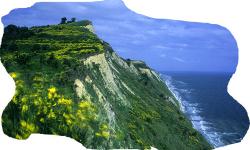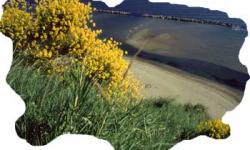The territory includes a succession of hills parallel to the coast; over time the lithological composition of these hills has created two geo-morphologically different sectors: the generally steep sector facing the sea and the more gentle rolling sector facing the hinterland.
The S. Bartolo Park is characterised by the stretch of high, intense sea-cliffs which go from Gabicce to Pesaro (Italy), a rarity in all of the Adriatic coast. The rest of the protected territory is made up of rural landscapes actively cultivated until the 1950s even in places which today would be unthinkable, practically reaching the sea.
Today, a part of the old cultivated lands have been returned to natural vegetation, while continuing to be the identity of an agricultural territory within the complex of the Park territory. Therefore, we will divide the S. Bartolo Park into two distinct areas, for homogeneous reading: the sea-cliffs and the inland side.
The first consideration to be made is that in the past the territory has been almost entirely cultivated, both because some of the slopes were less steep and because of the historic "hunger" for land of the Pesaro settlements. Therefore, there were no large mammals until the 1990s when the roe deer, in expansion over the entire provincial territory, made its way to the Park as well and found this environment, made up of a patchwork of cultivated land, open woodlands and shrubs, suitable for its needs. We also the fox, which roams the beaches as well, to feed on marine organisms, the badger and the porcupine.
One might expect an area so densely populated to be poor in flora: on the contrary, the S. Bartolo Park has many pleasant surprises in store for its visitors. A recent study of the “vascular flora” present in the protected area has shown that rare species are to be found throughout the region, with especially interesting species on the cliffs. On the cliffs above Baia Flaminia, for example, is found a very rare plant which goes by the name of “maritime flax”; this is the only area in the entire region where it grows. Equally significant are rushes (Juncus subnodulosus), and the rock carrot (Daucus giungidum), which can be found only in a very few other places on the coast of Le Marche. On the most rocky slopes, the small reed Arundo plinii is the plant most commonly found, while on drier and more stable terrain Spanish broom (Spartium junceum) grows in quantity, its bright yellow flowers scenting the air and making an unforgettable contrast with the brilliant blue sky and the blue-green sea.



S. Bartolo Park reviews
Login to comment